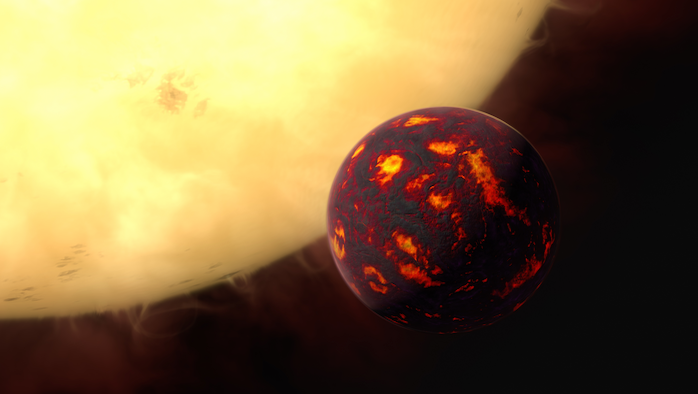Distant 'hell planet' with diamond core is the victim of a gravitational catastrophe
By Ben Turner published 8 days ago
The planet 55 Cancri e, also known as the "hell planet," appears to have been dragged closer to its sun's equator due to a gravitational anomaly.

An artist’s drawing of Janssen. The planet orbits its star so closely that its surface is a 3632 degree Fahrenheit (2000 degrees Celsius) lava ocean. (Image credit: ESA/Hubble, M. Kornmesser)
Scientists studying a distant "hell planet" where clouds rain lava, the oceans are molten and the core is filled with diamonds have found that the nightmarish planet wasn’t always so bad; but it became infernally hot after being yanked closer to its sun.
The planet, classified as 55 Cancri e, is nicknamed "Janssen" after Zacharias Janssen, a Dutch spectacle-maker who is dubiously attributed with the invention of the first optical telescope. The a rocky world, 40 light-years away from us, orbits its star Copernicus 70 times closer than Earth orbits the sun — meaning one of its years lasts just 18 hours.
But Janssen may not have always been this way, a new orbital analysis published Dec. 8 in the journal Nature Astronomy(opens in new tab) revealed. The planet orbits Copernicus, itself part of a binary pair with a red dwarf star, alongside four other planets; and while it was always hot, the planet may have only gained its hellish conditions after being reeled in toward its star's equator following shifts in the gravity felt from Copernicus, the red dwarf and Janssen's sister planets.
"We've learned about how this multi-planet system — one of the systems with the most planets that we've found — got into its current state," study lead author Lily Zhao, a research fellow at the Flatiron Institute's Center for Computational Astrophysics (CCA) in New York City, said in a statement.
More:
https://www.livescience.com/how-hell-planet-got-so-hot

